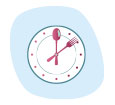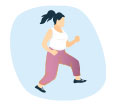Checking Your Blood Sugar
Checking Your Blood Sugar
Living well with diabetes means knowing how food, activity, and diabetes medications affect your blood sugar. Checking your blood sugar regularly provides information you can use to adjust eating habits and activities to manage your diabetes.
What numbers are right for you?
Blood sugar goals vary from person to person. Talk to your health care team about your goals and what is best for you.
Share
Getting started
Your health care team can help you decide if and when to check your blood sugar. They can provide a blood sugar meter and instructions on how to use it.
When to check
Work with your health care team to make a plan for testing your blood sugar. Common times to check are:
- When you first wake up and before you eat (fasting)
- Before meals
- 2 hours after the start of a meal
- At bedtime
Different ways to check your blood sugar
 Blood sugar meters are small devices used to check blood sugar levels. The results show the amount of sugar in the blood at the time of the test.
Blood sugar meters are small devices used to check blood sugar levels. The results show the amount of sugar in the blood at the time of the test.
 Continuous Glucose Monitoring (CGM) uses a tiny sensor under the skin to check blood sugar levels every 1 to 5 minutes, 24-hours a day. CGM devices can be linked to a cell phone.
Continuous Glucose Monitoring (CGM) uses a tiny sensor under the skin to check blood sugar levels every 1 to 5 minutes, 24-hours a day. CGM devices can be linked to a cell phone.
 Hemoglobin A1C is a lab test that measures your average blood sugar level over the past 2 to 3 months.
Hemoglobin A1C is a lab test that measures your average blood sugar level over the past 2 to 3 months.
| Goals for Blood Sugar* | My Blood Sugar Goals |
|---|---|
| Fasting or before a meal: 80 to 130 mg/dl | |
| 2 hours after meals: Below 180 mg/dl | |
| A1C: Less than 7% for most adults | |
| * These are general recommendations for people with diabetes who are not pregnant. | |
Blood Sugar Highs and Lows
| High Blood Sugar | Low Blood Sugar | |
| What is it? | Also known as Hyperglycemia. May or may not have symptoms. |
Also known as Hypoglycemia. Usually lower than 70 or when having symptoms of low blood sugar. |
| Why is it important? |
High blood sugar can cause low energy and long-term damage to eyes, kidneys, feet, and other parts of the body. |
Our brains need sugar to work well. Low blood sugar can cause confusion or fainting. |
| What are some symptoms? |
Weakness, blurred vision, thirst, or urinating (peeing) often. |
Hunger, confusion, dizziness, shakiness, or fast heartbeat. |
| What to do? | If your blood sugar is too high, drink water and limit sugars and starches. Talk to your health care provider. |
Treat low blood sugar. Have a sugary item, such as 4 oz. of juice, 4 glucose tabs, or 1 glucose gel. Retest in 15 minutes. |
If your blood sugar levels are too high or too low, you may need to make changes to:

What or when you eat and drink

Medications

Physical activity

Managing stress
Going UP
Things that may cause hyperglycemia
- Eating more than usual or a large meal
- Forgetting your diabetes medication
- Dealing with stressful situations
- Having an illness or infection
Going DOWN
Things that may cause hypoglycemia
- Eating less than usual or skipping meals
- Being more active than usual
- Taking more medication than prescribed by your provider


